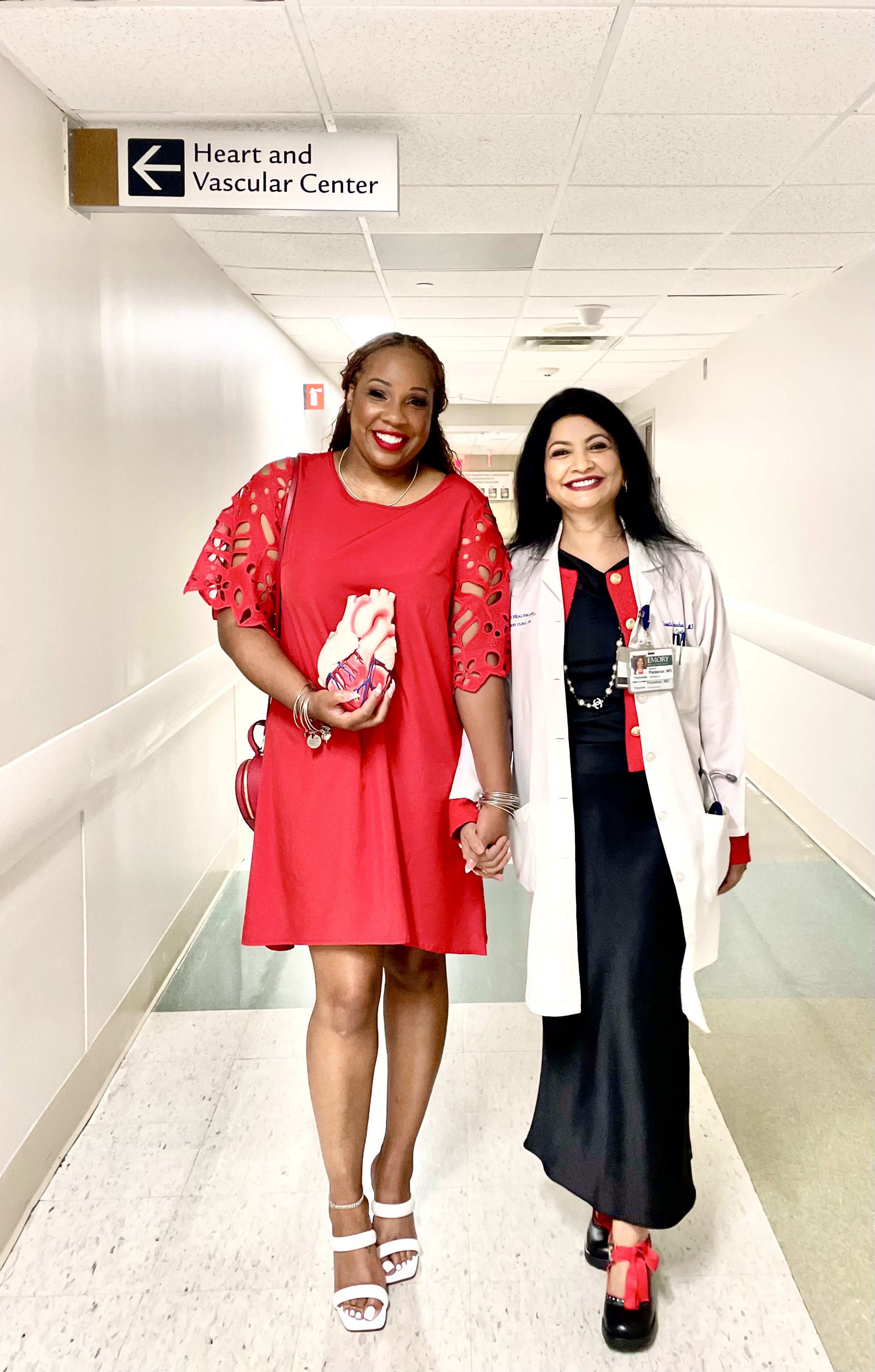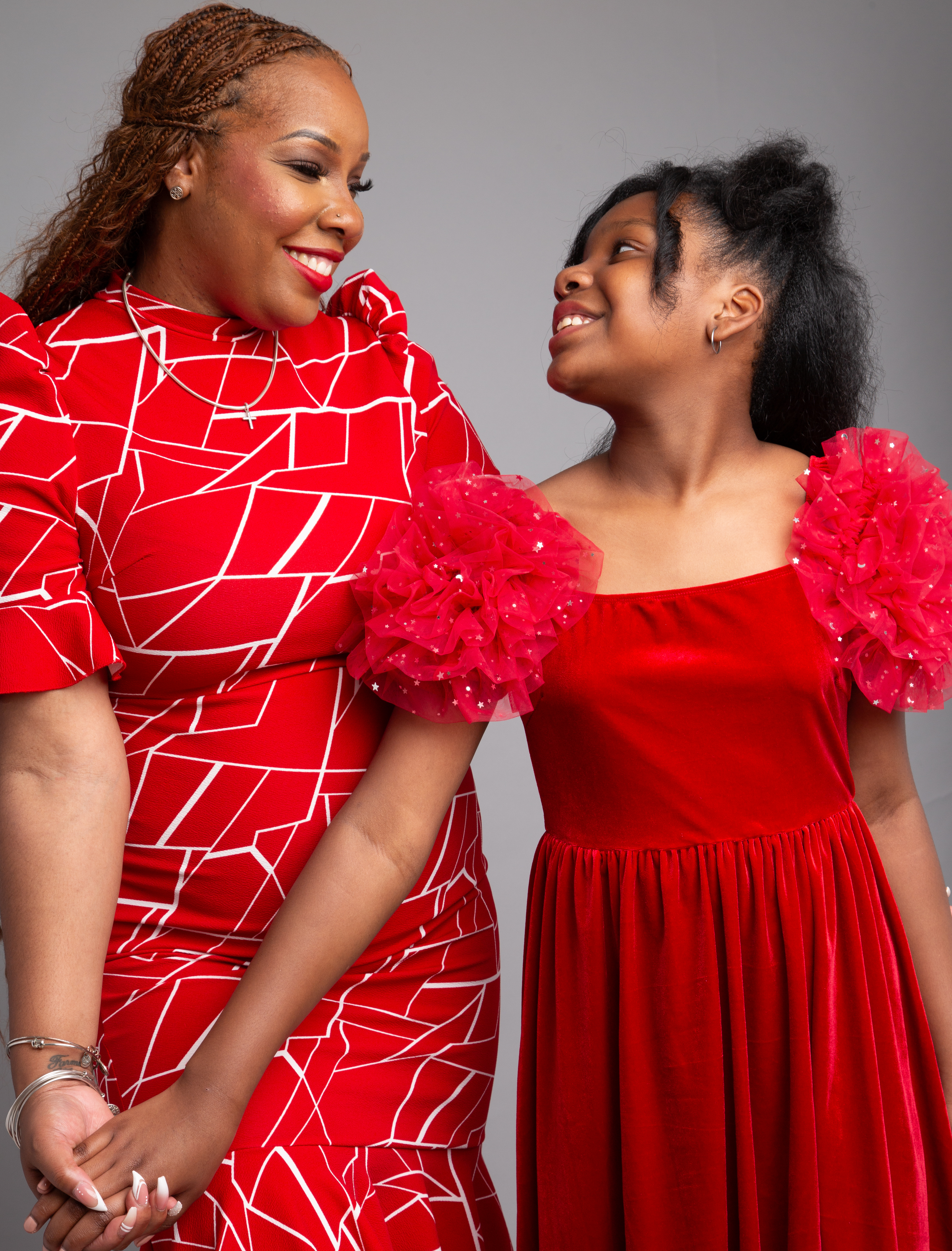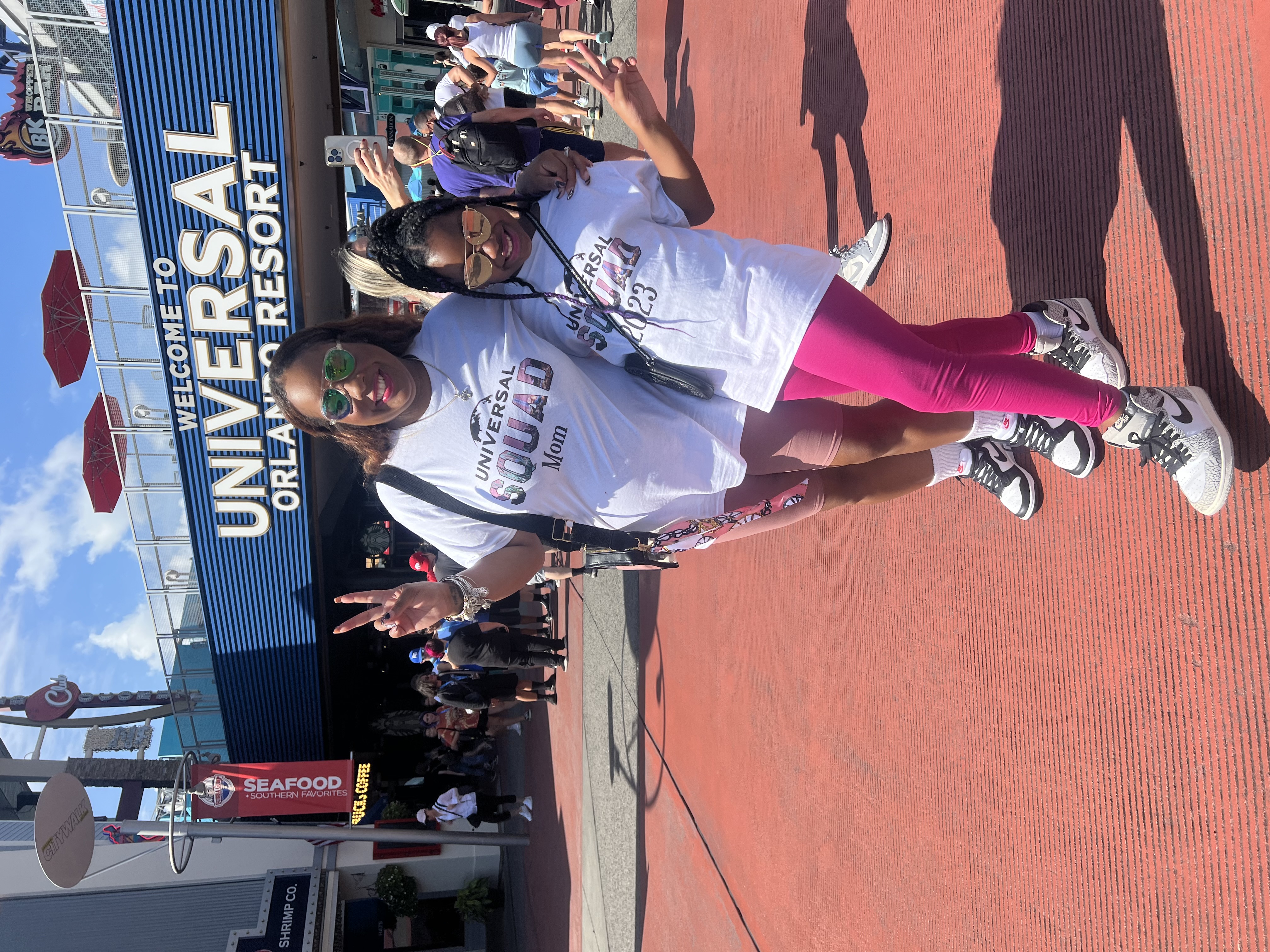Last winter, 39-year-old Toniya Farmer, DPT, was in a race for her life — literally, speeding on her way in the car toward the nearest hospital while experiencing the kind of doomsday chest pain that surely signaled a heart attack.
On the phone with her was a 911 operator, who advised her at one point to pull over to the side of the road. But, as she recalled later, “I knew if I stopped driving, I would die. Jesus literally took the wheel.”
Earlier that day, Dec. 28, 2023, the 39-year-old had been chatting with her mom while driving to a nail appointment. Her mom said she sounded off, and Farmer admitted that her chest had been hurting – but she had shrugged it off as likely just heartburn.
That’s when things worsened rapidly, Farmer recalls. It became “hard to talk, and hard to breathe.” Her mom told her to hang up the phone and call 911.
Now rushing to the hospital by car, the agonized Farmer saw a blue sign with a white H, pointing her toward a nearby hospital – one she had never been to. At that point, she remembers, the pain in her chest “was worse than labor pain.”
Luckily, there was an empty parking space near the Emergency Room and Farmer kept 911 on the line until she made it inside. “I literally fell across their desk and said, ‘I think I’m having a heart attack,’ but nobody moved,” she says.
Farmer, who works in health care as a physical therapist, lost her own father due to a heart attack when he was just 36. Because of that, she’s always paid close attention to any chest discomfort. That awareness had already led her to become a patient of Susmita Parashar, MD, more than a decade ago due to postpartum cardiomyopathy, which is new onset heart failure between the last month of pregnancy and five months post-delivery with no determinable cause.
“To me, her entire attitude is so inspiring," says Parashar, who has been right alongside Farmer every step of her health journey. "I see patients who have something happen and are so worried that they forget about living. But with Toniya, she’s living every moment and inspiring others to live, too. That’s outstanding and truly inspiring to me personally.” 
While the disease weakens heart muscles, Parashar noted that there was nothing weak about Farmer’s mind and fortitude.
“She’s a remarkable woman,” says Parashar. “She’s a physical therapist who is knowledgeable and compliant with her meds, who exercises and eats right.” Through interventions and hard work, Farmer’s heart had been holding steady for quite some time.
But that December day, Farmer knew something different was going on.
Farmer wasn’t near an Emory hospital and knew she needed help. Despite telling the front desk at the place she’d wandered into that she believed she was having a heart attack, providers at this other hospital initially misdiagnosed her as having a panic attack, due in part to her relatively young age.
“Unfortunately, this is not uncommon,” Parashar says. “It is important to note that women who experience chest pain or heart attack are less likely than men to receive timely, guideline-indicated testing, and therapies. It is very important for anyone, especially women, to know their body. Know when something is not right, seek care, and advocate for yourself. It is crucial for both physicians and individuals to be aware of disease risk factors, as well as cardiovascular signs and symptoms, in order to expedite and optimize care.”
Still, they ran an electrocardiogram (ECG), which checks out how the heart is functioning. By the time her mom and husband arrived, Farmer’s heart rhythm had returned to normal.
Or at least, so they thought.
Just moments later, the same chest pain came back, and Farmer asked her mom to get a nurse. Within five minutes, her heart went into a dangerous rhythm called ventricular tachycardia, and she had to be resuscitated with two shocks to the heart.
There’s a 10-hour gap in Farmer’s memories from the time she coded to when she woke up. Having been intubated in the intensive care unit (ICU), she returned to consciousness surrounded by family — and notes that she’s grateful her daughter, Aubri, was already with her grandmother that day.
The one memory she still has from that lengthy blackout was “this voice telling me that I was going to die,” Farmer says. “In my mind, that was the devil. And I told that voice, ‘I shall live and not die,’ which comes from Psalms 118: 117-118. I was fighting the whole time, I have a nine-year-old daughter who needs me. I didn’t know I coded, but God had me the whole time.”
Farmer with her daughter, Aubri Photo by Fatima Michon Photography
The intubation was removed once she was breathing on her own, but Farmer was still sent to have a full-body CT scan. The provider taking her downstairs shared how happy she was that Farmer pulled through, as it took 40 minutes to get her heart beating again. “I don’t have the words to express the feelings of gratitude I have for being alive, and that I have no brain damage or additional damage to my heart,” says Farmer.
A visit to the cardiac catheterization (cath) lab at that hospital showed Farmer had no blockages — just like the tests Parashar ran in 2016. But this experience was completely separate from Farmer’s previous diagnosis. Now, Farmer was diagnosed with severe coronary artery vasospasm, the sudden narrowing of an artery when the vessel’s wall quickly contracts and remains contracted, reducing blood flow to parts of the heart.
To prevent future episodes of cardiac arrest, Farmer was told she’d need an implantable cardioverter-defibrillator (ICD), which uses electric impulses to restore a regular heart rhythm and prevent sudden cardiac death.
At that point, Farmer asked to be transferred to her cardiovascular care team at Emory. From her bed in the ICU, she sent a MyChart message to Parashar. “That’s how much faith I have in her compassion and clinical expertise,” Farmer adds about her trusted physician.
When Farmer’s message came in, it so happened that Parashar was out of the country for the holidays — in the desert in Jordan with no cell phone signal. The hospital where Farmer was staying contacted the on-call doctor at Emory and explained that her patient wanted to be transferred to Emory.
It took a few days for a bed to open up at Emory University Hospital, but Parashar was in touch with Farmer throughout, calling from Jordan to let her know what doctor would be receiving her and advocating for the transfer on her behalf.
Parashar remembers being impressed by Farmer’s resilience and optimistic outlook during the whole process. “You would think a 39 year old who had a cardiac arrest and had to be resuscitated would be crying. But when I spoke to Toniya, she was so happy to be alive, and excitedly told me the whole story as if describing a movie she’d just watched.”
Farmer arrived at Emory around 2 a.m. on January 2 and was immediately greeted by the team. By 9 a.m., she was going to get her ICD. “Emory does not play around,” she says.
The ICD that Farmer received is an especially advanced version called a subcutaneous ICD, which gets attached to the heart via wires. The care team, led by cardiologist and cardiac electrophysiologist Michael Lloyd, MD, placed this specialized ICD under Farmer’s left armpit and attached it to an electrode. This process is far less invasive than traditional ICDs, and less likely to involve any complications, Parashar explains.
“The subcutaneous ICD is ideal for younger patients like Toniya because it does not require wires, or leads, to be placed in the heart through the bloodstream,” says Lloyd. “These types of wires, which are used in other types of defibrillators are the Achilles' heel of traditional ICDs because they are prone to infection and breakdown. This is extremely important for younger patients who expect to live many decades with their devices. The subcutaneous ICD is FDA-approved and Emory has been on the forefront of research to establish this technology.”
Although Aubri didn’t want to see her mom while sick, the two FaceTimed consistently. “My daughter sent me a list of all these cute things we’d do together when I was back home, including seeing ‘Renaissance: A film by Beyonce,’” Farmer says.
Farmer was discharged from Emory two days after she arrived, with instructions not to drive for two months and to follow her new medication routine. She still managed to pick her daughter up from school that day as a surprise, and went home surrounded by her village, including her own mom, who moved in to help with caretaking responsibilities so Farmer’s husband could continue to work.
A week after she went home, Farmer had a follow-up visit with Parashar, who told her she wanted Farmer to visit the Mayo Clinic, to see a colleague who specialized specifically in coronary artery vasospasm and (SCAD).
Parashar says she also wanted to make sure that Farmer – who showed no signs of blockages in her arteries but had such a cardiac arrest – got a genetic consult for this extremely uncommon condition.
Parashar called her Mayo Clinic colleague from Farmer’s bedside, discussed her case in detail, and facilitated an expedited referral. Farmer was able to get an appointment scheduled for early March at the Mayo Clinic headquarters in Rochester, Minnesota. Traveling with a sorority sister and best friend from high school for moral support, she underwent a battery of new tests and was additionally diagnosed with SCAD, an emergency condition that occurs when a tear forms in the wall of a heart artery, which can also slow or block blood flow to the heart.
Ninety percent of SCAD cases are women, mostly between the ages of 30-60, and the condition accounts for roughly 25% of all heart attacks in women under 60 years old. The cause of SCAD is still unknown — making it “spontaneous” — but it is believed that it starts with the artery wall weakening. Possible causes of weakened artery walls are fibromuscular dysplasia, genetics, multiple pregnancies, connective tissue disorder, and hormonal changes, among others. SCAD can also be triggered by highly emotional events or physical stresses.
When she was in the hospital recovering, Farmer says, “My daughter sent me a list of all these cute things we’d do together when I was back home." Among those things? Twinning as mother-daughter adventurers.
While she doesn’t yet have all the answers about what her life will look like one, five, or 10 years from now, Farmer is now working with her Emory team to decrease the risk factors she can control, like weight, diet, exercise and medication compliance. Because physical therapy often requires lifting significant weights, Farmer is carefully planning with Parashar the best path forward.
Part of her recovery has been attending cardiac rehab, which Farmer says has given her the stamina and confidence she needed to live her life again.
“To me, her entire attitude is so inspiring,” says Parashar. “I see patients who have something happen and are so worried that they forget about living. But with Toniya, she’s living every moment and inspiring others to live, too. That’s outstanding and truly inspiring to me personally.”
Farmer is still working to get her stamina and strength back up, and to navigate what her work as a physical therapist looks like with restrictions on how much weight she can lift. She’s also connected with a therapist to work through the trauma of the experience and identify areas in her life where she can reduce stress. But she’s back to spending time with her family — including helping to care for her grandmother — and attending church.
She’s also much more present in her daily life now and has completely left social media behind. While her initial reaction was to return “to the rat race,” she pivoted and created boundaries for herself, instead. “Certain things just don’t matter anymore,” Farmer says. “The things that matter to me are my husband, my daughter, my grandmother and my mother.”

